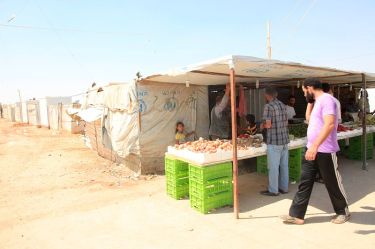The Refugee Cities concept builds on two related models: self-administered and self-sufficient refugee settlements and special economic zones.
Self-Sufficient Refugee Settlements

In Nakivale, Uganda, refugees have been given rights to land upon which they can build homes and farm. Algeria allowed refugees from Western Sahara to work in textile plants, which were successful but hampered by shortages of materials and restrictive centralized control of production by the government. Tanzania also organized settlements of refugees from Burundi as a means of developing under-utilized regions in the 1970s.
Even in these settlements, most of the refugees’ economic activity has been informal or illegal. Refugees living in camps along the Thai-Myanmar border frequently work illegally, as both the refugees and the employers are eager for the opportunities. Refugees in Dadaab, Kenya – which is the world’s largest refugee camp – run businesses that sell food rations to people in the local community.

Markets have also formed in the Zaatari and Killis refugee camps, which house Syrian refugees. This is a further step toward more self sufficient communities.
Making economic activities legal, such as through issuing licenses, would help curb abuses, open up access to financing, and produce more economic benefits for the host countries.
Special Economic Zones
Special economic zones have gained popularity in recent decades among poorer and middle-income countries. When designed well, the zones act as policy “incubators” in which good ideas can be sparked, proven to be successful, and lay the groundwork for nationwide reforms.
As an example, many of the economic reforms that have fueled China’s growth over the last 20 years were first “tested” in the Shenzhen Special Economic Zone, which is located next to Hong Kong. The reforms in Shenzhen were so successful that many members of the Chinese Communist Party were persuaded to allow the reforms throughout the entire country.

Similarly, a refugee city would introduce reforms to a key obstacle to progress in many countries – the barriers to refugees entry to the labor market. By removing this barrier within a limited area, a country’s leaders can overcome the political resistance to allowing refugees to work across the entire country.
Refugee cities can also benefit from a half century of lessons learned about the institutions, laws, and administrative structure that make for successful special-status zones. Typically the best zones offer investors a better business environment than the surrounding area through better quality and more efficient delivery of public services, reduced bureaucracy, and high-quality infrastructure.
Special Economic Zones Best Practices
Refugee Cities will endeavor to incorporate some of the best practice features of special economic zone management learned internationally whenever possible, such as:
Refugee cities can benefit from a half century of lessons learned about the institutions, laws, and administrative structure that make for successful special-status zones.
- A dedicated government regulatory authority with a high capacity and legal authority to monitor and enforce the law in the cities.
- Efficient access to government through a “one-stop shop,” that can issue all permits, licenses, visas, and other approvals, coordinate these functions with other relevant government entities and assist residents and businesses with these services.
- Development, service provision, and maintenance by experienced private sector or public-private companies
- Broad-based political support in the host country government
- Selecting locations based on where demand from investors exists, or would exist, if certain constraints were lifted.
- Letting “bottom-up” market forces determine spatial planning and investment decisions rather than “top-down” planning.
- Easing trade barriers through duty-free entry of goods, efficient customs declarations processes, other non-tariff measures that make it easier for goods and services to enter and exit the country through the cities.
- Subsidies and government intervention targeted to expand opportunities for the poor.
- Skills training centers
- Gender empowerment through childcare, safe and respectful workplaces, ensuring promotional opportunities for women, etc.
- Labor counselors that regularly visit places of employment, inform workers and employers of their rights and obligations, help employers comply with labor obligations, and receive and investigate confidential complaints from workers.
__
For more information about the precedents for the Refugee Cities concept, see our resources.